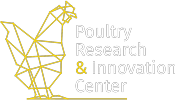
PRIC
Poultry Research & Innovation Center

PRIC
Poultry Research & Innovation Center

PRIC
Poultry Research & Innovation Center

PRIC
Poultry Research & Innovation Center
About PRIC
The global poultry industry is facing big challenges nowadays. On the one hand innovation are focussed on animal health, animal welfare and food safety and on the other hand new innovations had to be investigated and tested for economical feasibility.


Antibiotic use
In the past the production of poultry meat has increased a lot. The housing of many broiler together under conventional conditions may lead to increased pressure of animal diseases. At that moment the poultry industry had easy access to antibiotic use, which could be used to cure the animals. After some years the industry tried to optimize the production of poultry meat by means of low levels of antibiotics in the feed to optimize digestion and feed conversion. In 2006 the use of so called ‘antimicrobial growth promotors’ in the European Union was forbidden, because of the development of antibiotic resistance. Nowadays leading integrations and retailers are challenging the poultry industry to produce poultry meat without antibiotics.

Vaccination
Bacterial infections are often secondary to primary viral infections. In the last decades several vaccines are developed to prevent animals from viral infection. Broiler breeders are vaccinated several times to prevent themselves and their offspring from viral (and some bacterial) infections and the offspring (broilers) are also vaccinated against multiple diseases.
The use of vaccines increased the health status of the poultry stock and improved daily weight gain, feed conversion en reduced mortality and rejections at the slaughter house.
Intestinal health
Nowadays the focus of the health status of poultry lies more and more on the digestive system. In the digestive tract live millions of bacteria, which live in close contact with the immune system of the host. If the so called microbiome lives in a good balance with the immune system, the health status of the animal lies on a high level. A disbalance of the microbiome causes activation of the immune system, which costs a lot of energy. This may lead to improved performance and economical loss.

Research & Innovation
Modern poultry research is focused on improving animal health by improving the feed and the housing system. The food can be improved by changing the structure, the composition and the addition of several additives like enzymes, probiotics, acids, etheric oils, etc. Further on the use of new resources like European soybean meal and insects are promising examples for more sustainable poultry production.
Poultry Research & Innovation Center
The Poultry Research & Innovation Center (PRIC) in Emmen in the Netherlands provides a well-equipped facility to measure the effects of new innovations in the broiler industry. In the facility new products (additives, new feed formulas, hatching and/or housing systems) can be tested under diverse conditions. Trials are set-up in consultation with R&D managers of chemical / pharmaceutical companies and are most of the time custom-made to provide repetitive, reliable results. By means of this the PRIC maintains long term relationships with leading companies in the poultry industry.

Contact
Modern poultry research is focused on improving animal health by improving the feed and the housing system. The food can be improved by changing the structure, the composition and the addition of several additives like enzymes, probiotics, acids, etheric oils, etc. Further on the use of new resources like European soybean meal and insects are promising examples for more sustainable poultry production.

